Durian: The King of Fruits – Absolutely Delicious, But The Smell Is Unforgettable (And That’s Putting It Mildly)
by Ken Gargett
The first description I ever heard of the durian fruit was that it was like “eating custard over an open sewer”. I never forgot that . . . but who wouldn’t be curious?
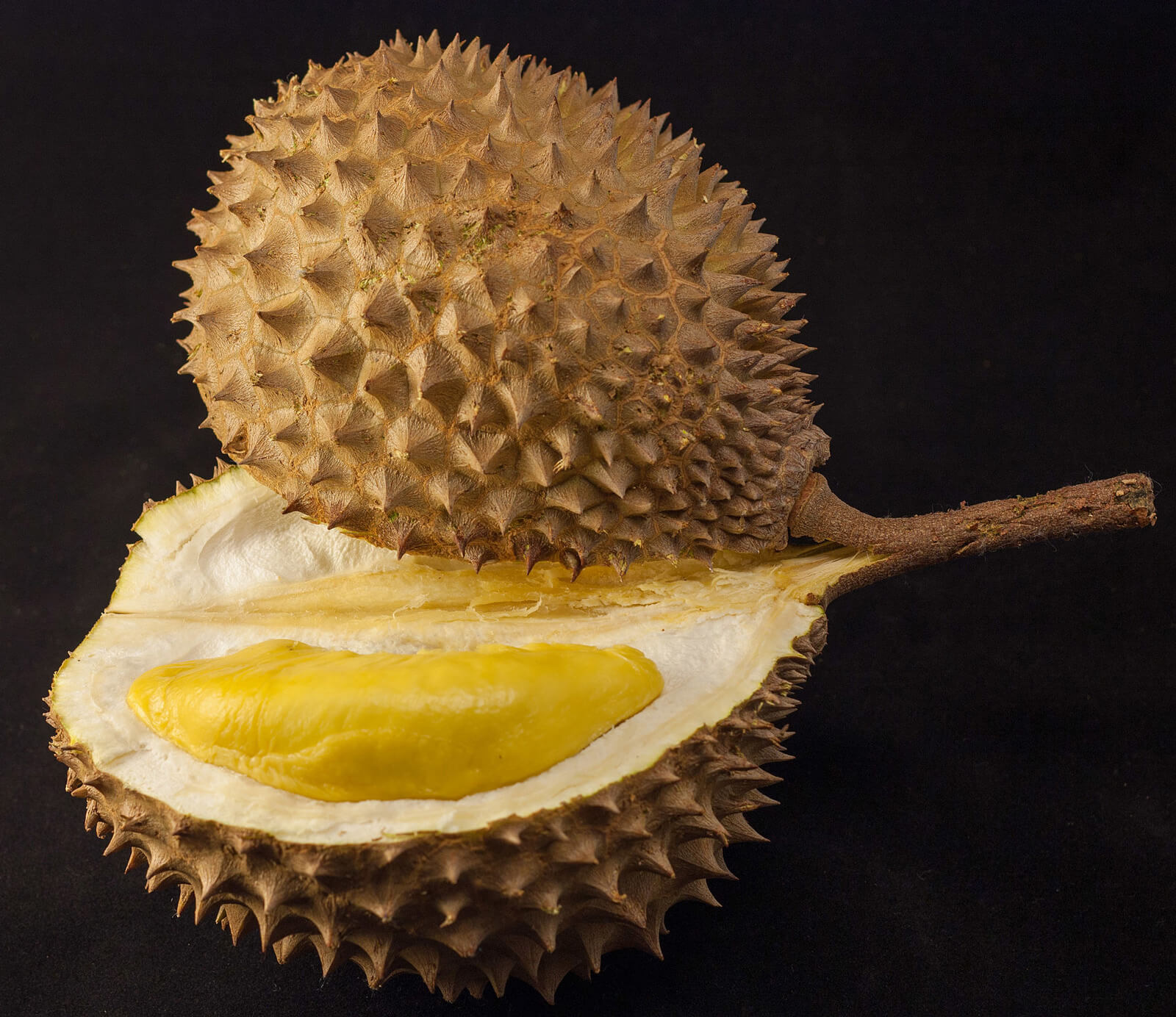
Durian fruit cut open (photo courtesy مانفی/Wikipedia)
A 1903 glossary of Anglo-Indian words and phrases described durian as “carrion in custard.” A few years later, the Australian Naturalist, Edmund J. Banfield, countered with “an unrivalled delicacy… the one case where Nature has tried her hand at the culinary art and beaten all the Cordon Bleue out of heaven and earth.”
So which is it? For some, durian is one of the greatest delicacies on earth; for others, an abhorrent, putrid, repulsive aberration, unthinkable as fit for human consumption. Now, I am aware that writing about matters controversial is not always appreciated, but in this case, I am hoping I am on solid ground for a number of reasons. First, durian is often described as ‘the King of fruits”. Secondly, according to my research, it is the most expensive fruit ever sold. Finally, I was first introduced to durian by our very own Ian Skellern, when traveling in Asia.
Opinions do vary. Anthony Bourdain described it as “like pungent, runny French cheese … Your breath will smell as if you’d been French kissing your dead grandmother.” The highly respected ‘Oxford Companion to Food” does not hold back, “Comparisons have been made with the civet cat, sewage, stale vomit, onions, and cheese; while one disaffected visitor to Indonesia declared that the eating of the flesh was not much different from having to consume used surgical swabs.”
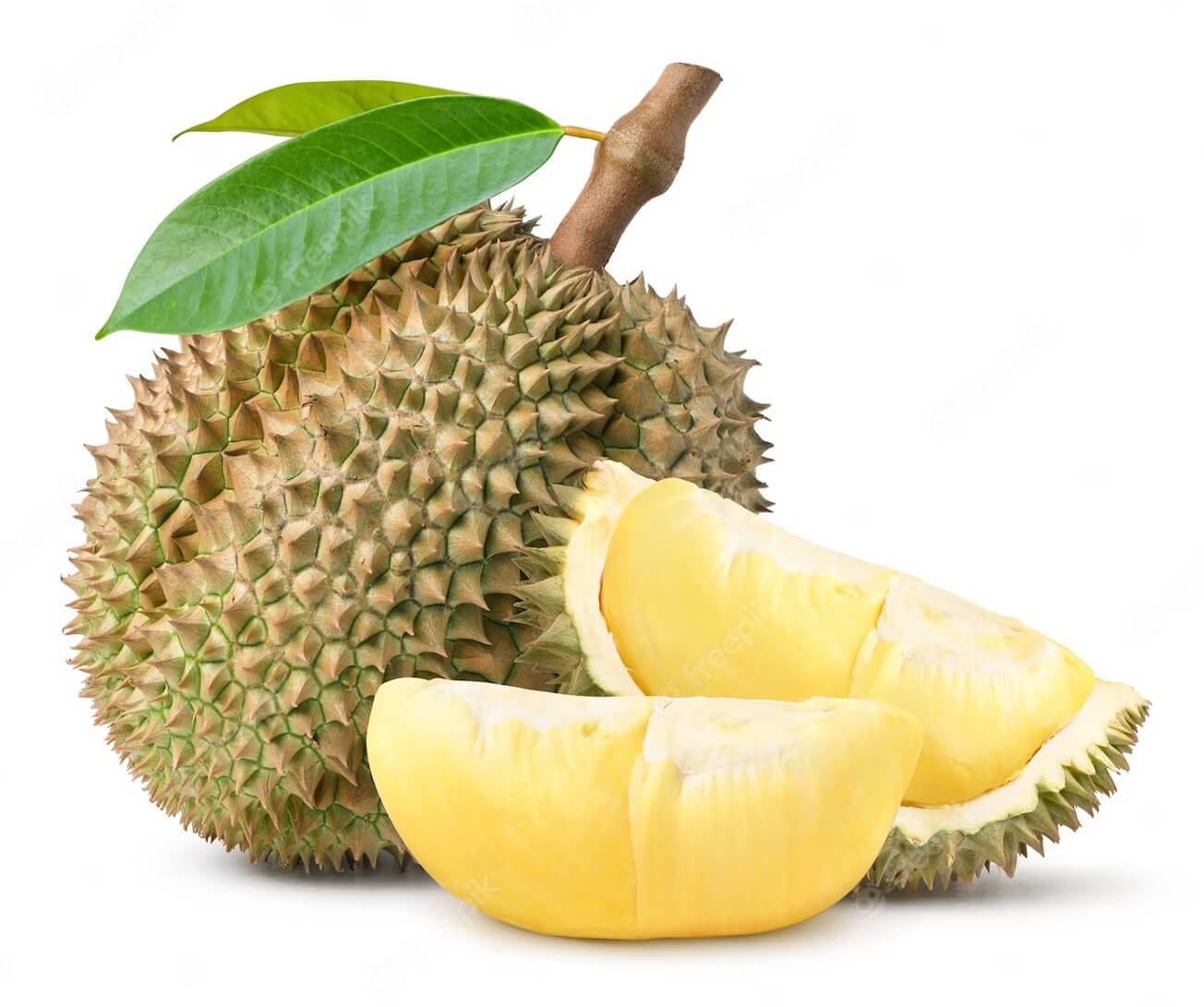
Durian fruit and flesh
Other ‘reviews’ – ‘its odor is best described as pig-sh*t, turpentine and onions, garnished with a gym sock. It can be smelled from yards away”; “to eat it seems to be the sacrifice of self-respect”; “to anyone who doesn’t like durian it smells like a bunch of dead cats”; “vomit-flavored custard” (thank ‘The Rough Guide to Malaysia, Singapore & Brunei’ for that one); “the smell of rotten eggs”; “sewer-gas overtone”; “like the flesh of some animal in a state of putrefaction”; “eating ice cream in an outhouse”; “imagine to have under your nose a heap of rotten onion and you will still have but a faint idea of the insupportable odor which emanates from these trees and when its fruit is opened the offensive smell becomes even stronger”; “completely rotten mushy onions”; “like eating raspberry blancmange in the lavatory” (this one from novelist Anthony Burgess); “it can smell like a dead animal” and much more.
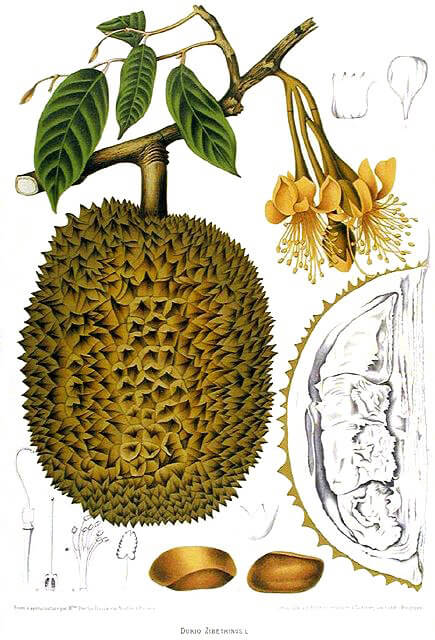
Durian fruit sketch (image courtesy Hoola Van Nooten/Wikipedia)
Some sit on the fence – the 19th-century British naturalist, Alfred Russel Wallace, wrote, “a rich custard highly flavored with almonds gives the best general idea of it, but there are occasional wafts of flavor that call to mind cream-cheese, onion-sauce, sherry-wine, and other incongruous dishes”; the Italian explorer, Giovanni, wrote in 1908, “I must say that I have never tasted anything more delicious. But not everyone can enjoy or appreciate this strange fruit for the disgusting smell that distinguishes it and that is apt to cause nausea to a weak stomach”; Thomas Fuller of the New York Times wrote of the resemblance to dead animals, but also said “get down to the pale yellow, creamy flesh, and you’ll experience overtones of hazelnut, apricot, caramelized banana and egg custard… But words fail; there is no other fruit like it.” This love-it-or-hate-it approach, odd for it to be not so much dividing the crowd but within each person, is very much the hallmark of this fruit.
The way the smell appeals to some but repulses others reminds me a little of Sauvignon Blanc wine. Some adore the grape while others find it utterly repellent.
Durian has, however, long been adored by many and not just in its Asian homeland. The 17th-century missionary, Jacques de Bourges, wrote, “the flesh is as white as snow, exceeds in delicacy of taste of all our best European fruits, and none of ours can approach it.” Not sure that I’ve ever seen one where the color can be compared to snow, but he was obviously a fan. Its immense popularity, however, especially in Southeast Asia, where it is a revered delicacy, speaks volumes. Durian has even inspired local architecture.
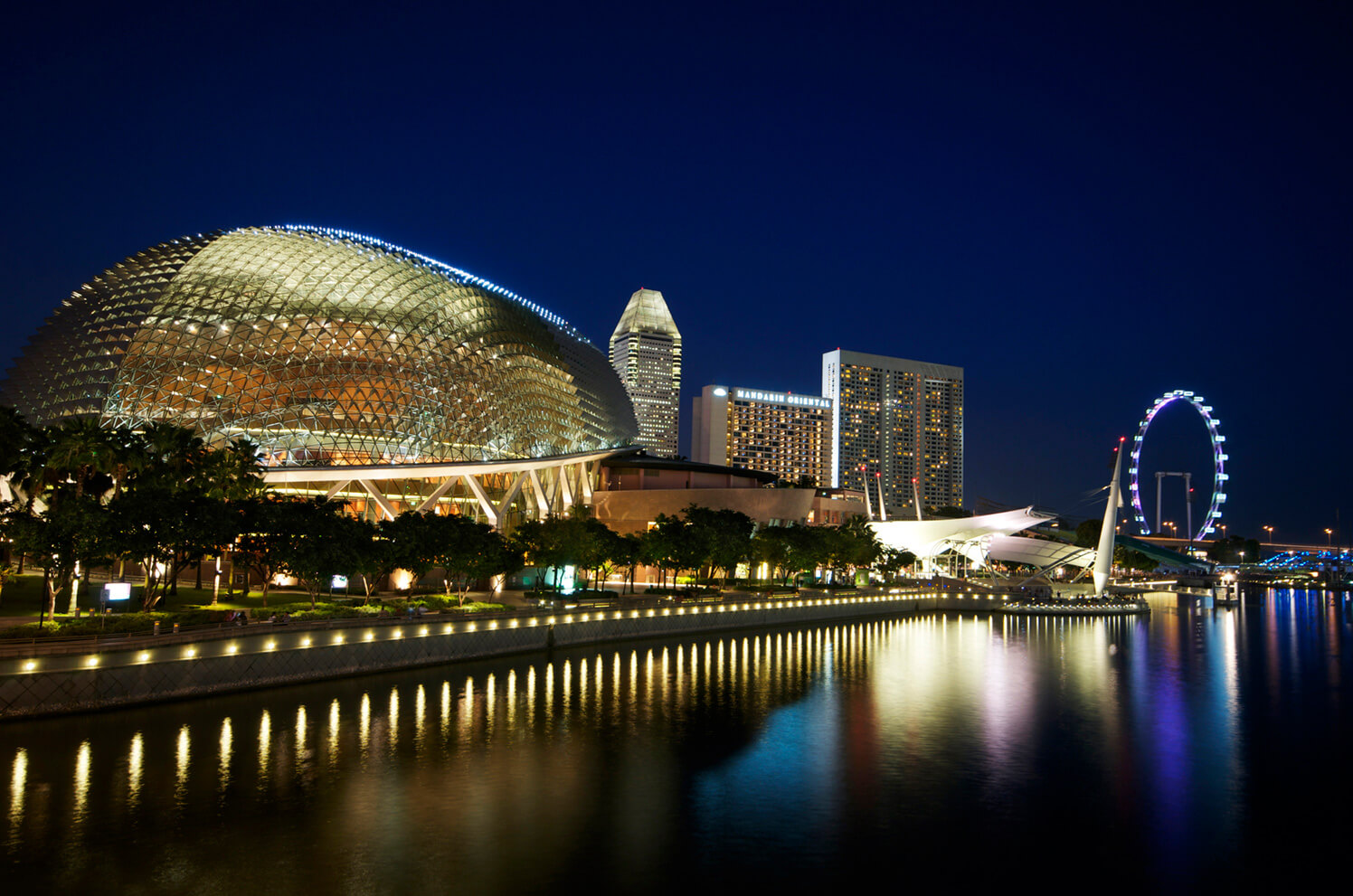
The Esplanade – Theatres on the Bay (photo courtesy William Cho/Wikipedia)
The Esplanade – Theatres on the Bay in Singapore was designed to resemble a giant durian.
It is not all plain sailing. Because of their pungent odor, they are banned from Singapore’s public transit systems. Many hotels in Southeast Asia also ban durian from their premises.
Further afield, on the Isle of Man, firefighters were called to deal with a gas leak. Eventually, they tracked the problem down to a rather potent durian. In China, a man failed an on-the-spot breathalyzer test and was accused of drink-driving. He swore he had not touched any alcohol but had been eating durian. Subsequent blood tests confirmed no alcohol, whereupon a group of police officers put durian to the test. All failed their breathalyzer tests, taking them to almost twice the legal limit.
At the Royal Melbourne Institute of Technology, more than 500 students and lecturers were evacuated due to a gas leak. It was simply a durian hidden in a cupboard. Apparently, the same thing happened on a university campus in Canberra. In Indonesia, a flight was grounded after the passengers complained of the smell – there were durian in the hold. Before the flight could depart, the durian had to be removed.
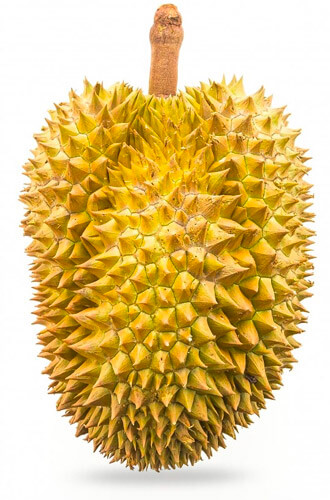
Durian fruit (photo courtesy www.super-marmite.com)
Naturally, I had to try a durian for the purposes of this article (any excuse…) and several days later, the house and fridge were not yet completely free of the smell. I asked various friends their thoughts on this most divisive of fruits. One confessed that as much as he loved a former girlfriend, her love of durian meant that the relationship had no chance and he was forced to break up.
Fans of the fruit will pay almost anything they can to get hold of a durian. In season, even if you don’t reside in Southeast Asia, they should be readily available in many cities in the better Asian markets and supermarkets. For my latest one, I paid A$12/kilogram and they usually weigh from around two to four kilos, but can reach six kilos. Good quality durians, when in demand, will go for considerably more.
I asked the lady at the local market to pick one that would be perfect for consumption in the next day or two – there is always the concern that some of the more unscrupulous might use that as an opportunity to offload a dodgy one to the clueless buyer (I figured that even in that case, I’d learn something and forty bucks is not the end of the world), but she did a great job (as happened, I had to delay eating it by a day as we lost power just before I was about to cut into it and in the dark, torch only, it seemed wise to wait a day – you need a large, very sharp knife and a fair bit of force). It was tending to be fractionally overripe by the time I ate it, which can allow the tiniest intrusion of a vinegar-like note, but that is a minor quibble. I loved it!
There are times, however, when the price skyrockets. Until recently, a Yubari King Melon held the record for the most expensive fruit, a pair going for US$45,000 (though they can usually be obtained for only a few hundred dollars). These melons take one hundred days to grow and ripen, during which time they are massaged daily and apparently, often even given hats for protection.
Recently, however, this was topped by a wealthy Thai lover of durian who paid an eye-watering US$48,000 for one (it is possible that a portion of this staggering amount was destined for charity).
Not all durians are equal. There are around 30 different species. Of these, only nine or ten produce the edible fruit so adored. Durio zibethinus is the species most common around the globe (no surprise that the scientific name for the Indian civet cat, an animal known for its unappealing odour, is Viverra zibetha and there is debate as to whether the name came about because they both stink, if one may put it bluntly, or because civets are so fond of eating durian). Durians are native to Sumatra and Borneo. Vietnam, the Philippines, Cambodia, Brunei, Singapore and Malaysia, as well as Indonesia, all have various species growing locally.
As well as the distinctive aroma, a durian has also been described as resembling a medieval weapon. Usually a bright green, though occasionally tending to a browner hue, they are football sized though often oddly shaped and are covered with seriously spiky thorns (the word for thorns in the local Malay is duri). Care needs to be taken while handling them to avoid injuries. I was aware that falling coconuts killed many people in Asia annually, but I would imagine that one of these landing on your skull from a great height would do even more damage (yes, I understand that there are no degrees of dead). Apparently, these days, anyone working in durian plantations wears a hard hat.
The flesh inside the husk is a pale cream/yellow. Some species apparently give red flesh, though I’ve not seen one. There are five segments containing the pulp in each fruit,.
Many assume durians to be a close relative of the jackfruit which has a very similar appearance, though smaller spines and less dangerous. They are not related. What is rather curious is that genome testing has revealed that the plant most closely related to the durian is cotton.
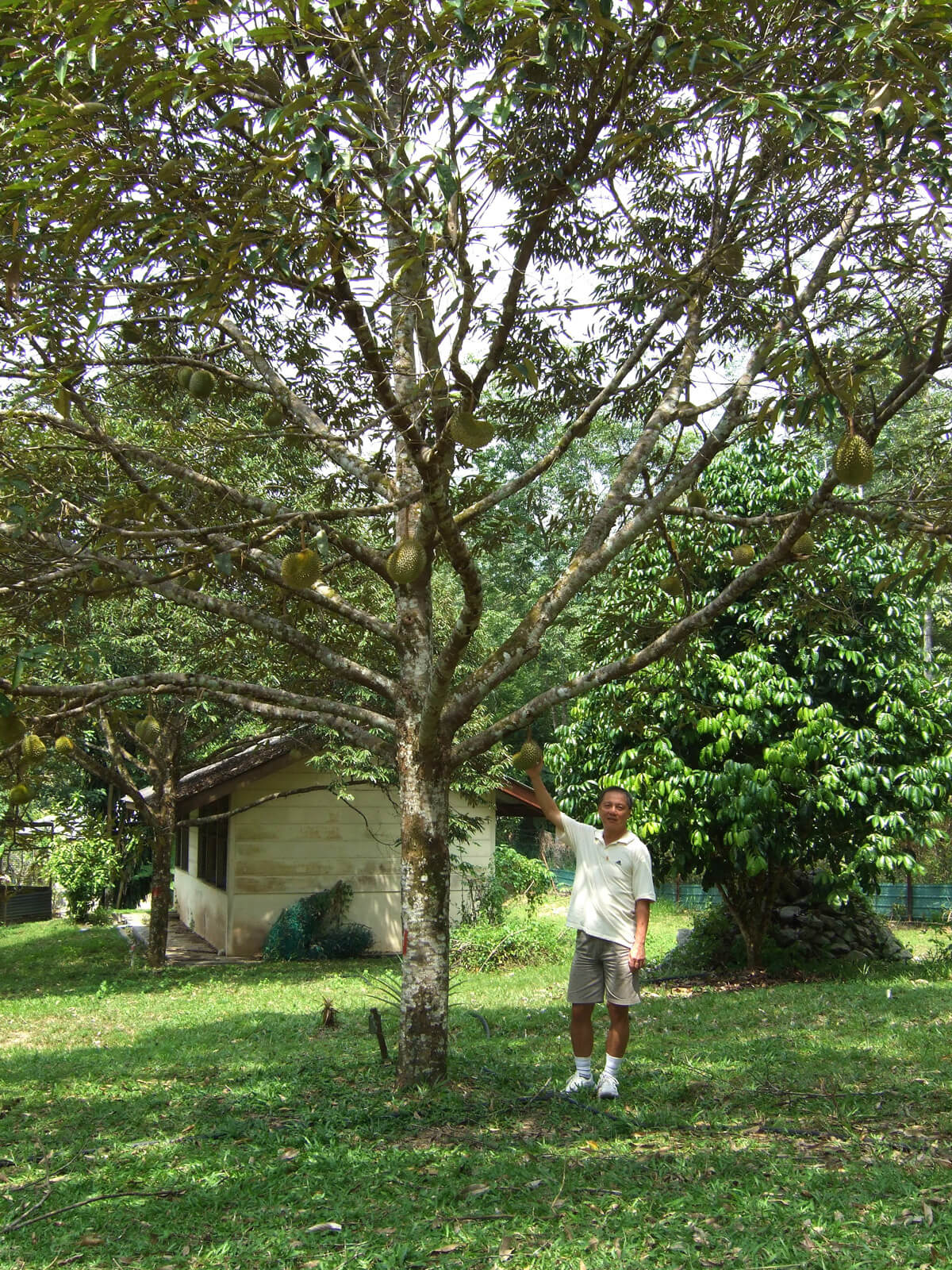
Durian tree in Malaysia (photo courtesy Yun Huang Yong/Wikipedia)
Trees can grow up to fifty meters high and can produce hundreds of fruits, which will start appearing after four to five years. The fruit takes about three months to fully develop. I have some seeds to give growing one a try, which is apparently possible (the tree prefers the tropics but can handle climates where the daytime temperatures do not drop below 22°C – if that happens, the tree stops growing), although if I suddenly had a fifty-meter tree in the yard I’d have a new set of problems. Suggestions for the care of a durian tree note that you need to be careful if orangutans are local to your area as they are likely to take to it. Fortunately, that’s not likely to be a problem in Brisbane. Durian flowers are almost exclusively pollinated by bats, although certain species of sunbirds and giant bees also play a role. The main season for the fruit is June to September.
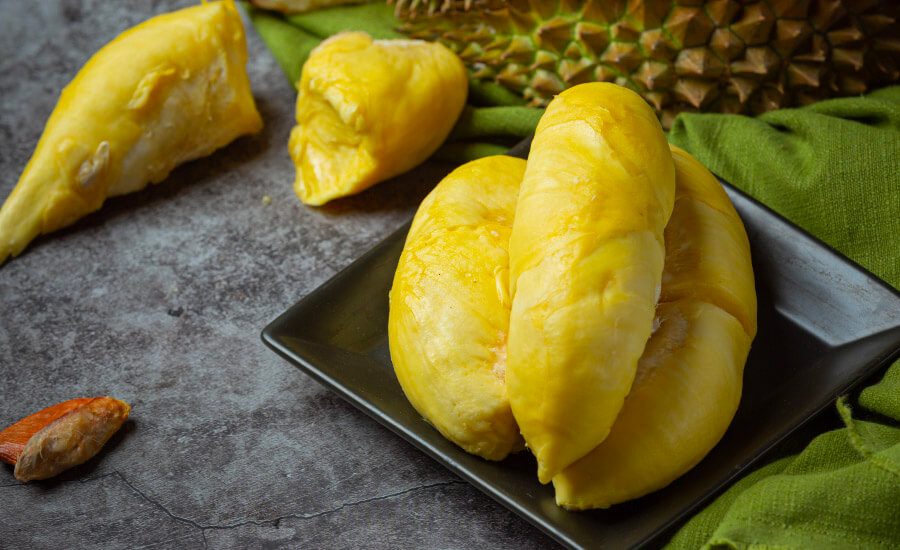
Flesh of the durian fruit (photo courtesy www.super-marmite.com)
The most popular breed of durian is the Musang King. It dates back to the 1980s when a gentleman from Pahang, Tan Lai Fook, found a tree in Gua Musang in Kelantan (a State in northern Malaysia). He cut off a branch and grafted it. Musang, in Malay, references the palm civet. The flesh of this breed is bright yellow and it is now the most sought-after durian in Malaysia, Singapore and Vietnam. Some will claim that the blackthorn durian is even better, but my friends from the region assure me that, while both are wonderful, the Musang King is more reliable and more consistent. They insist that to be at its best a blackthorn durian needs to come from an old tree.
Thailand is the world’s largest exporter of durian, growing some 700,000 tonnes annually, even though the fruit is not native there. Of their production, 400,000 tonnes go to China and Hong Kong. Malaysia and Indonesia both produce over a quarter of a million tonnes annually. These countries now have large-scale farming operations for this fruit – this has contributed to deforestation in these regions and the adverse impact on the local wildlife. Even Australia, also a country where durian was never native, exports over 100,000 tonnes just to China and Singapore. More elsewhere.
The reason for the pungent odor is the existence of ethanethiol, or ethyl mercaptan, in the fruit. Humans can detect its odor in as little as 0.36 parts per billion. It is a minor component of petroleum and is even added to various odorless gaseous products in order that humans can quickly detect gas leaks. This came about because in 1838, the Union Oil Company of California noticed that at any leak, turkey vultures would quickly gather, attracted by the rotten smell. So they increased the amount of ethanethiol in the gas to make the detection of any leak easier.
These smells help attract animals in the jungles that love the fruit and help to disperse the seeds. The armory of thorns discourages smaller creatures, meaning that the larger animals are more likely to disperse the seeds over a greater area – good for the continuation of the species. Pigs, deer, orangutan, elephants, sun bears and even tigers are known to eat durian when they can. It seems that animals do not have the same aversion to the fruit that afflicts humans.
For humans, the degree of preferred ripeness tends to vary from country to country. They will continue to ripen after harvesting. For the larger trees, it is necessary to wait until the fruit falls. Many will freeze durians until they get to market, wherever that might be. Obviously, simply cutting them open and eating the fruit/pulp within is a common method of consumption, but durian is also used in rice dishes, curries, bread, pancakes, sauces, cakes, soups, juices, candies, desserts, milkshakes, ice-cream and much more. They are even made into durian chips at times. Fermented durian paste is often served with catfish. Provided they are cooked, the seeds can also be eaten.
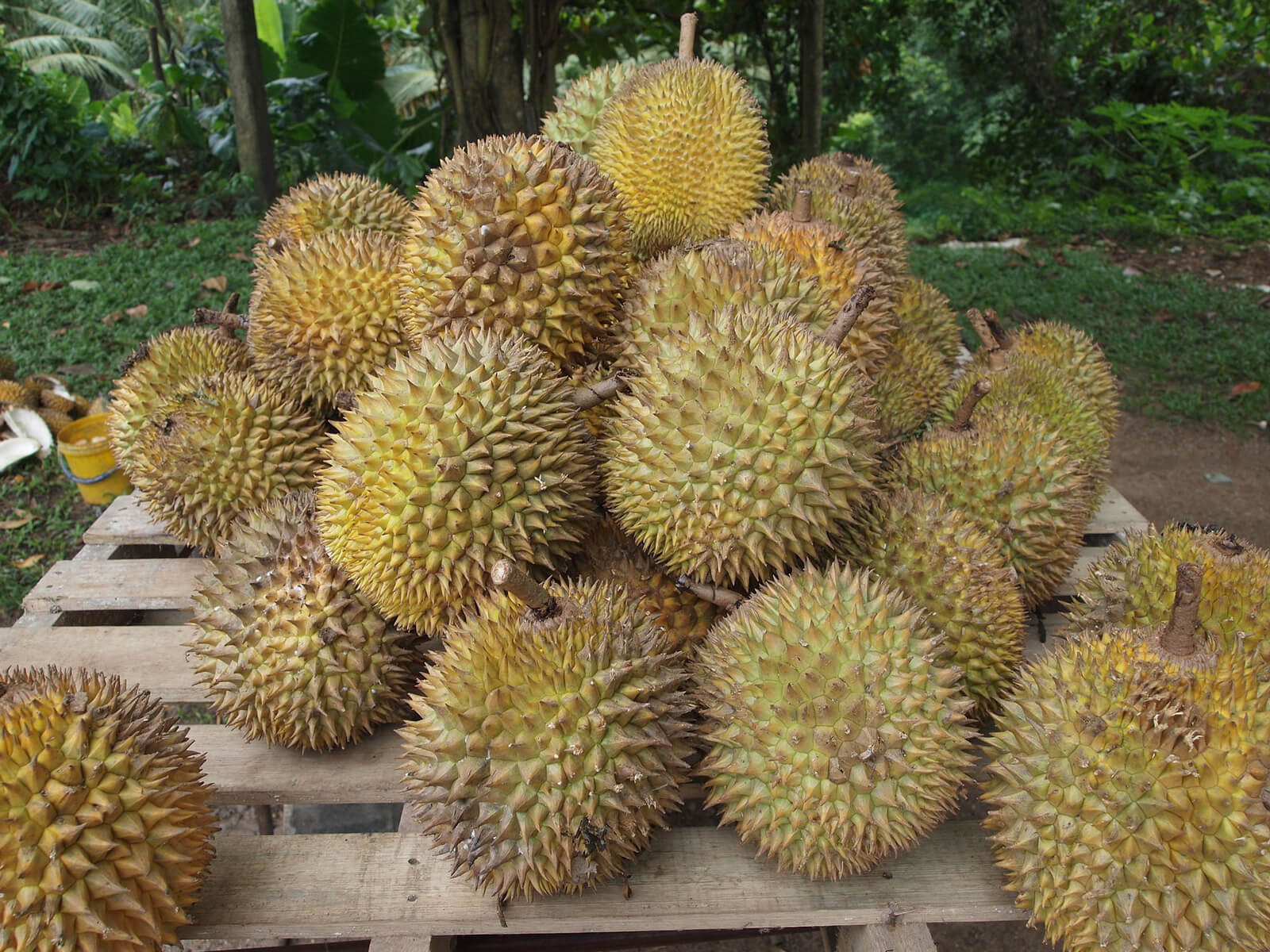
Durian fruit (photo courtesy Kalai/Wikipedia)
While delicious – or not, if you do not like them – durians are considered to be extremely healthy (some also believe them to be an aphrodisiac – I guess better them than killing rhinos for their horns or tigers for other parts, under the same delusion, though no doubt equally ineffective). Health benefits vary depending on species, but in general, durian fruit/pulp is 65% water, 27% carbohydrates (which includes 4% dietary fiber), 5% fat and 1% protein. So, 100 grams of durian, which can be raw or fresh frozen, provide between 30% and 60% of the daily requirement of thiamine (sources on this vary), and contributes to other B vitamins, vitamin C (80% of the daily requirement) and more. On average, 100 grams will provide between 10 and 40% of the daily requirement of manganese, B6, potassium, riboflavin, copper, folate, magnesium and niacin. Durians are especially rich in oleic acid and palmitic acid. They are also high in antioxidants. Search the internet and it is difficult to find anything that durian won’t allegedly cure. Truly, a superfood.
That said, apparently, too much durian can be unhealthy, especially for your liver, but fear not. It is estimated that a person weighing 70 kilograms would have to eat 1.2 tonnes of durian in a day to be harmed. I suspect one’s bank account would suffer far more than your health if you attempted that.
So, is there any particular wine that pairs with durian? There has long been a belief that consuming either coffee or alcohol with durian is to be avoided. The jury is out on this, but it is understood that the high sulfur levels in the fruit do work to help prevent the efficient removal of toxins from the body to the extent of 70%.
In the end, you need to make up your own mind, assuming you can find them. Some will avoid durians religiously and nothing I say will change that. I strongly recommend even the biggest skeptic do everything they can to get a really good one first up (start with a bad one and that will surely be the end) and to give it a go. You may find a new passion.
Finally, the Thais are so enamored of durian that they are testing sending some of the flesh into space on unmanned space flights to see how it fares (Thailand is yet to actually get to space so you can see their priorities), examining texture and taste. The plan is to be ready to ensure that their astronauts, when the day finally comes, will be well catered for – as much as I love the stuff, I am not sure I would want to be in a confined space with that smell for four or five days, no matter how good it tastes.
You might also enjoy:
In Praise Of Great Mezcal: All Tequila Is Mezcal, But Not All Mezcal Is Tequila (And Avoid The Worm)
Laws In The World Of Wine And Spirits: The Good, The Bad, And The Idiotic
Leave a Reply
Want to join the discussion?Feel free to contribute!



unknown to me.
excellent article.
Thanks Cuentatiempos. Much appreciated. It was a fun one to research.
…Oh my God. After reading this article and laughing my ass off over the descriptions of this ever unheard of fruit, it knocked the current “Flu” right out of me totally. Is it available here in the U.S. …let’s hope not. But on second thought….
Thanks Cameron. Can’t promise it will cure the flu but worth a shot.
It mightn’t clear Cameron’s flu, but it’s likely to clear his nasal passages!
This durian is decious and ram is a bit of a seat and I like it subscribe to the grocery shop and I like
I have encountered durian many times in Asia, but have never been able to get near enough to actually try it. You can smell it in the market before you even get there. The funniest thing to me is that when you check in at the airports in Thailand, there is a picture of a durian with a line through it indicating that you are not allowed to take it on the airplane, for good reason!
Lisa, fully understand but if you can fight past the aroma, the rewards are worth it.
A. P. R.: THEASURAS for Awful
Farming effect same as SOY
YUCK
As an Indian, Mango is my favorite and Durian is the 2nd in the list.
Hi Abdul. As a Queenslander, mango is a huge local favourite here. Grown in the north of the State (mostly – plenty of places will have a mango tree in their backyard), good mango is a gift from the gods. The best local species we call Bowen mango – Bowen is a town in north Queensland. The big problem we have is that the fruit bats also love them and can strip a tree.